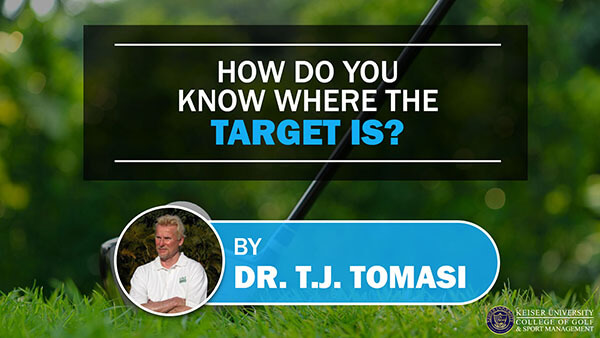How Do You Know Where the Target is?
How Do You Know Where the Target is?
The Strange Experience Called “Blindsight” – Part 1
by Dr. T. J. Tomasi, Keiser University College of Golf Senior Faculty and Director of Research

In 1967, Nicholas Humphrey at the University of Cambridge in England removed the visual cortex of a monkey named Helen, but surprisingly, after an adjustment period, Helen could navigate through a room of obstacles with no problems, even though she could not physically see.
Since then, studies have concluded that under certain conditions, the brain has alternate pathways that wire-up to allow humans to respond to visual stimuli with no conscious recognition of seeing – they are blind but they can still ‘see’ their environment.
Since Helen, the phenomena of blindsight has most often been studied as a response to brain injury, but I suspect its permutations are much more common in healthy people – in fact, I believe that a form of blindsight runs sub-rosa in all of us – a channel of perception that contributes to the images we create that make known our environment.
I believe that this hidden power can be developed via training, as our research at Keiser University suggests.
Neuroscientist Caspar Schwiedrzik at Rockefeller University in New York says: ‘… blindsight is interesting because it shows very dramatically how much processing is going on under the hood, outside our awareness.’
He describes his research as follows: ‘the brain is an organ that continuously adapts to its environment and can be taught to improve visual perception.
Although we assume we can see everything in our field of vision, the brain actually picks and chooses the stimuli that come into our consciousness.
The study reveals that our brains can be trained to consciously see stimuli that would normally be invisible.’
This documents my belief that the great players don’t see the same golf course as do average golfers, for, in addition to normal pathways, the great ones use a subconscious form of blindsight networks to detect aspects of the target scene that others don’t even know they are missing.
I believe it is this form of blindsight rather than the golf swing per se that is responsible for the performance differences separating excellence from “almost.”
Once you get to a certain level of proficiency, superior physical performance depends on the activation of unused powers that we all have but most rarely cultivate.
It is these latent in-house powers that are made manifest by brain/body training.
Of course, you must have a physical swing you can count on, but if, 60 years ago, you watched a lineup of 50 of the best young players hit balls on the driving range, would you have picked out Jack Nicklaus and his flying elbow as the greatest player ever?
Nicklaus, by his own admission, ran a detailed video of the shot and its outcome before making his actual swing.
It is my belief that the champion’s edge is the ability to create detailed internal imagery assembled by using data others don’t even see, let alone process. But this is merely the tip of the blindsight iceberg.
Even in practice, Nicklaus imaged every shot before he hit it. William Blake, the famous artist, poet and ecstatic, when asked where he lived responded ‘In my Imagination.’ Nicklaus when asked where he played could give the same answer.
There is another interesting aspect of blindsight – we know it is susceptible to stress, because blindsight is interrupted by tension, just as is normal perception.
Dr. Humphrey describes Helen’s mitigation of blindsight under stress: ‘Although I found it hard to put my finger on what was wrong, my sense was that she still did not really believe that she could see.
There were telling hints in her behavior. For example, if she was upset or frightened, she would stumble about as if she was in the dark again. It was as if she could only see provided she did not try too hard.’
But while you have this undeveloped power of blindsight, you still must nurture it by specific training and by honing stress protection protocols – you must attend to both, since stress can disrupt blindsight and lack of training will make it lay fallow.
Under the stress of pulling off a tough golf shot, most of us, like Helen, can “see” better when we don’t try so hard; in fact, sometimes you don’t have to see it at all to hit the target. In the next article, I’ll introduce the Olympic archer who is blind, but finds the target quite nicely.
Read part two of this series here.
If you enjoyed this golf tip, here’s how you can get even more. Contact Keiser University College of Golf about a golf degree.














